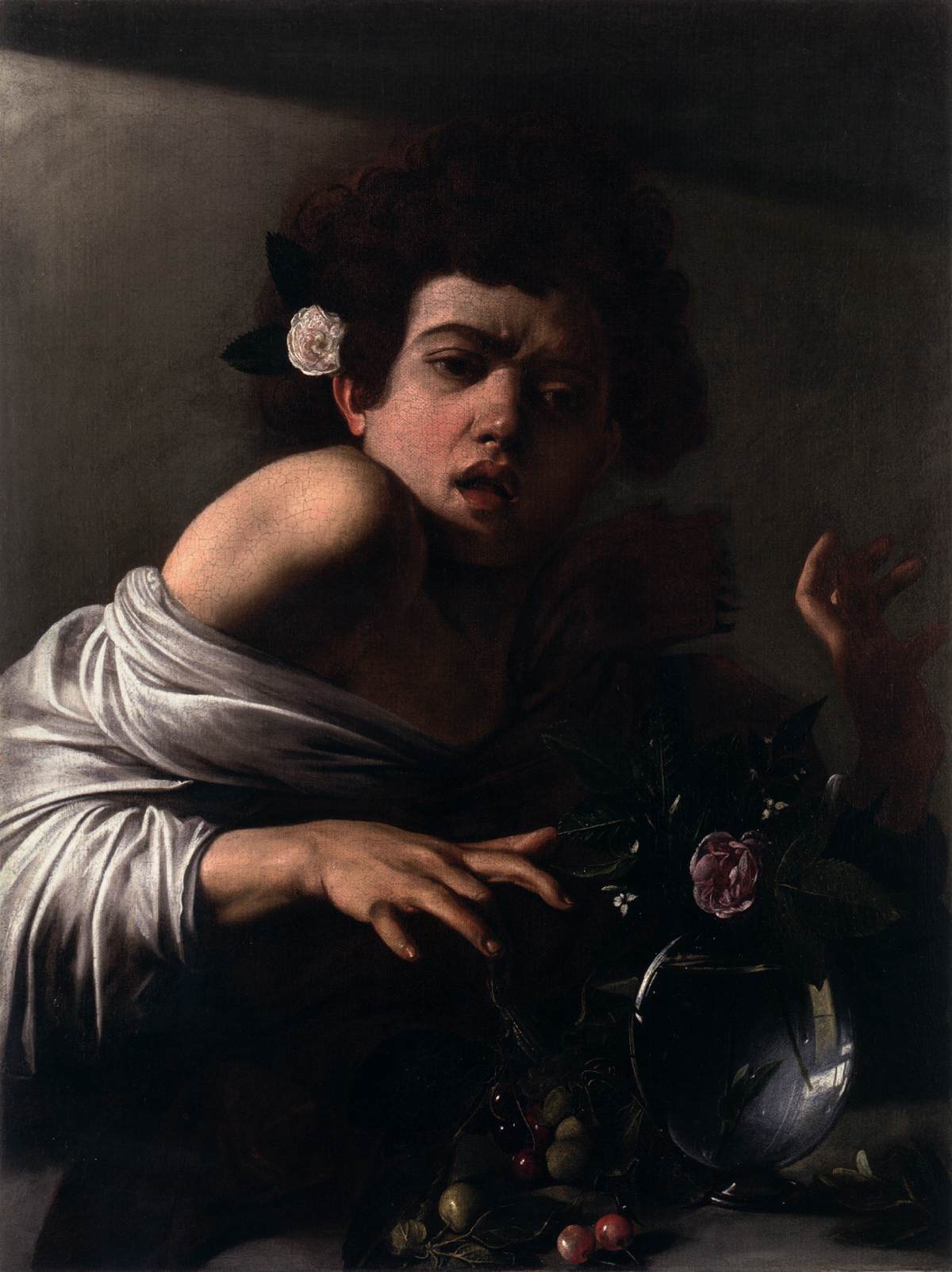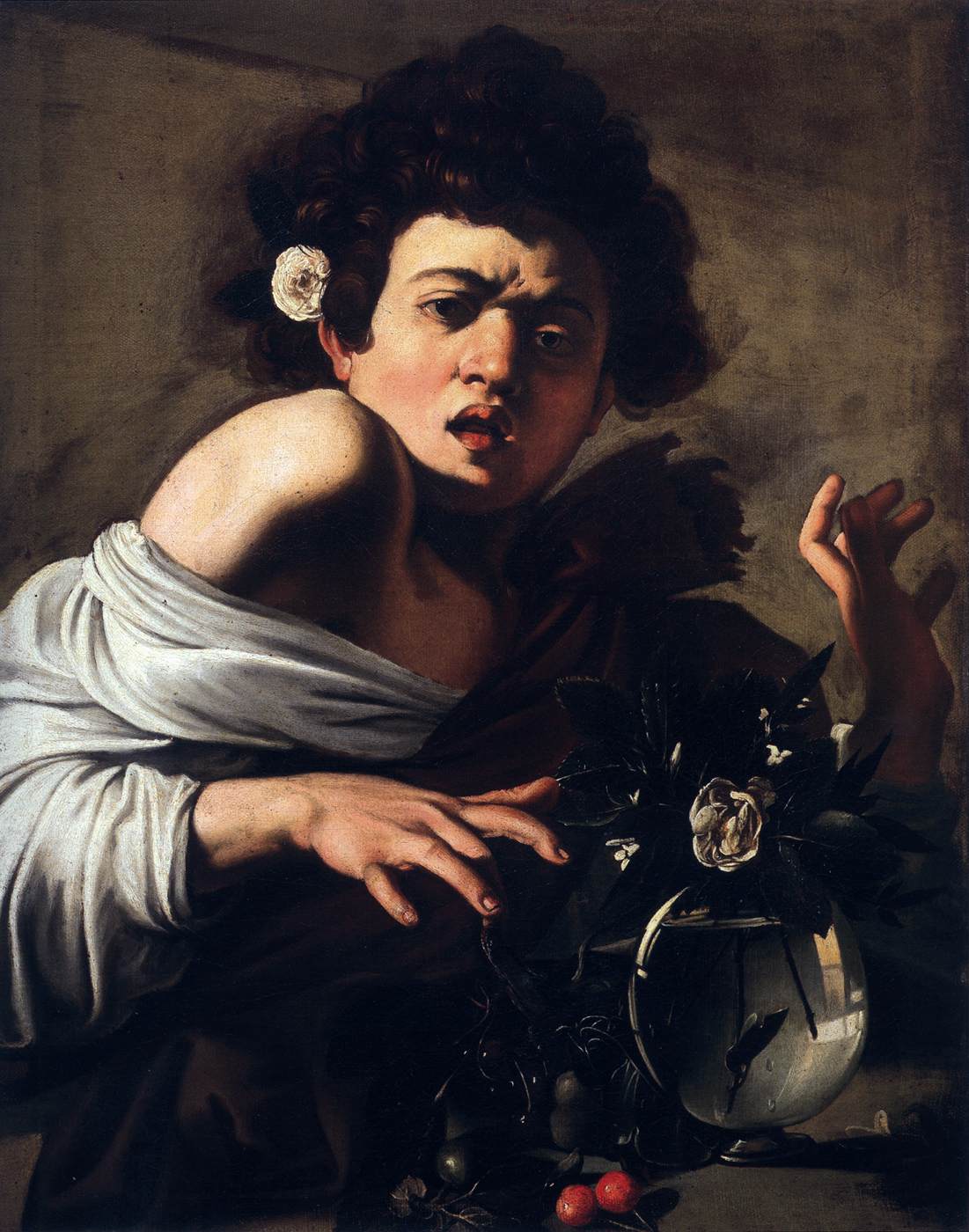Monday, September 20th, 2010
Boy Bitten by a Lizard: Posner vs. Gilbert
 About this time of year, several years ago, I was assigned my absolute favorite project in graduate school. I was required to read every single published work about one work of art, in order to trace the artwork’s historiography. I ultimately decided to research Caravaggio’s Boy Bitten by a Lizard (c. 1594).
About this time of year, several years ago, I was assigned my absolute favorite project in graduate school. I was required to read every single published work about one work of art, in order to trace the artwork’s historiography. I ultimately decided to research Caravaggio’s Boy Bitten by a Lizard (c. 1594).
Soon after I began to research my topic, I discovered that there are actually two versions of this painting – and both are attributed to Caravaggio. One version (shown left) hangs in the National Gallery in London, and the other (shown below, right) is in the Fondazione Roberto Longhi in Florence. Several connoisseurs argued over the authenticity of the paintings during the 20th century, but that debate essentially ended in 1992 (when Denis Mahon asserted that both examples are original, although he thinks that the Florence version was painted several years earlier than the London version).1
The most interesting thing I learned from my research project, however, was that one single article can forever change the shape of discourse (for better or for worse). In 1971, Donald Posner wrote a seminal article on the homo-erotic nature of Caravaggio’s early paintings.2 Posner argued that Boy Bitten by a Lizard is one of the most pronounced homosexual characters painted by Caravaggio. He finds the boy in this painting to appear sensuous, androgynous, and seductive (as suggested by the off-the-shoulder robe). Since that 1971 article, just about everyone has latched onto this homo-erotic theory and it still remains (mostly) undisputed.
What is interesting to me, though, is that no one (not even Caravaggio’s contemporary biographers) ever mentioned anything about homosexuality or effeminate characteristics until 1971. If this was such a key part of Caravaggio’s work, why was it unmentioned (perhaps unnoticed?) for centuries? I think that “Posnerian” scholars have imposed a 20th century perspective on this painting, and we need to rethink some of the homo-erotic interpretations of Caravaggio’s work. Creighton Gilbert also has come to this conclusion, arguing that the fair appearance of youthful men, was long celebrated in society.3 Gilbert argues that it was only during the nineteenth century, with the rise of capitalism, that men no longer wanted to be considered beautiful. The life of the artistocrat was not considered a social ideal anymore, for it was replaced by work ethic. With this change, men (particularly those of the middle class) began to insist on their difference from women, which not only changed clothing, but also changed other social norms (such as men kissing or crying).
From a historical (and historiographic!) perspective, I think that Gilbert’s argument makes a lot of sense. I also like much of Gilbert’s argument that this painting has roots in classicism. Gilbert finds that Boy Bitten by a Lizard was inspired by a Latin poem which was popular during the time of Caravaggio: O treacherous boy, spare the lizard creeping toward you; it wants to die in your fingers. The elements in this painting point towards this poem, including the bare shoulder, which recalls classical antiquity (instead of homosexuality, as interpreted by Posner).
What do people think? What was your immediate reaction upon seeing this painting for the first time? (Did you think that the subject was “effeminate” or merely “classical”?) Are we so entrenched in homo-erotic theory that it is difficult to examine this painting in any other way?
P.S. This post was indirectly inspired by the ongoing contest at Three Pipe Problem. People can submit a limerick about Caravaggio in order to win a copy of Andrew Graham-Dixon’s new book, Caravaggio: A Life Sacred and Profane. Last night I was thinking up words that rhymed with “lizard,” and decided I also better write a Boy Bitten by a Lizard post.
1 See Keith Christiansen and Denis Mahon, “Caravaggio’s Second Versions,” The Burlington Magazine 134, no. 1073 (August 1992): 502-04.
2 Donald Posner, “Caravaggio’s Homo-Erotic Early Works,” Art Quarterly 34 (1971): 301-324.
3 Creighton E. Gilbert, Caravaggio and His Two Cardinals (University Park, Pennsylvania: The Pennsylvania State University Press, 1995).

I'm going to have to agree with you and Gilbert on this.
My first impression of this painting is far from anything homosexual or erotic at all. And, I like you, think of all of the period books I've read based around the 1800s or so, and men were very much "feminine" (at least by industrial period standards). Though (and this is totally unrelated) I think it could be argued that society is taking a turn back into feminizing men with the whole "metrosexual" movement).
Very interesting post.
Absolutely stunning post M – and thanks for spreading the word about the comp!
I didn't know about the Florentine version – I will go see it – maybe it's been moved to the Uffizi exhibition that is on at the moment? I'll find out soon 🙂
I must admit – I don't see the homosexual link myself. Andrew Graham-Dixon spends some time on Caravaggio's sexuality in his book – he doesn't really buy into it either – Caravaggio may have slept with men as well as women, but trying to ascribe 16th Century values to a modern interpretation is always frought with peril.
Waldemar Januzczak did a great special on this particular painting in his 'Every Painting Tells a Story' series – I think I'll post a little clip over at 3PP later today to supplement this wonderful post!
The lizard motif is great, and a quite common one – particularly in the Northern still life paintinsg which had some influence on Caravaggio.
Kind Regards
H
Like you, I've heard the homoerotic interpretation–not just for Caravaggio's early paintings, but for works like Donatello's David. I think this theory originates with Freudian analysis and is therefore definitely colored by our 21st-century viewpoint. On one hand, I feel like one COULD make an argument for it, but it should be backed up with other evidence–i.e., the person who commissioned these paintings had a particular taste for such imagery or was known as an "admirer" of young men, for example–before it's repeated in every classroom from here to Italy, but it's a little too late for that.
On the other hand, you mentioned that this painting is rooted in Classicism, and Classical art WAS homoerotic. There's no doubt artists knew the Greek preference for older men taking boys as lovers. I feel like the whole series of paintings of young boys plays off of that in a very humorous, subversive way. They show Caravaggio as both educated and clever, and that's probably the main purpose of the homoerotic overtones, not lasciviousness.
For those who enjoyed this fabulous post by M – feel free to come have a look at a lovely related video clip and some reference material looking at the digitus impudicus, the offending finger that lurks behind the inference of homosexuality attributed to these paintings!
http://2.ly/c5vr
@heidenkind! I am delighted you mentioned Donatello's David – the whole feather = homosexual inference business just does not fit with this statute as a showpiece of the Palazzo Medici!
I covered what this feather *really* means in this early article at 3PP which I'm sure not many have read – one of my personal faves.
Donatello's David: How to banish the Dark Ages with a skinny bronze
Kind Regards
H Niyazi
Ha! I think that's a really interesting observation about feminizing men with the "metrosexual" movement, e. Interesting. I can totally see what you are saying.
H Niyazi, I was just about to let writers know about your post, but you beat me to it! Thanks for including the link to your interesting post. Let me know if you come across the Longhi version when you are in Florence. I'm not sure where it is on display, but it might be at the Uffizi right now.
heidenkind, I totally agree with what you are saying about evidence. It's only through evidence that we can really be sure that our 21st century mindset isn't messing up historical interpretations. (I guess postmodernists would argue that our mindset will always affect what we do, but at least historical evidence helps us to minimize the damage!) And I think you've brought up a good point about how homoerotic art existed in classical times. We can't discount that.
It would be interesting to know who ended up buying this painting. Mancini records that Caravaggio made this painting "for sale," so it seems like the artist wanted to attract a buyer. I just wonder what kind of target audience Caravaggio envisioned for this painting.
Actually the argument that one would need other examples to support theory is seen if one only looks toward Caravaggio's "Boy with Basket of Fruit" and also "Bacchus." All three of these paintings have similarities that COULD (not will) draw conclusions about the boy's or the artist's sexuality.
Personally, my history or western art teacher never once implied the homosexuality in these paitings, and I myself did in fact become suspicious of it by my own accord.
also, just for the mention of who bought what, and why–
"The Bacchus was most likely commissioned by Cardinal del Monte the year after Caravaggio entered his court. Cardinal del Monte commissioned around 40 paintings from the artist, many depicting relatively effeminate, sexualized young men.
Given that the Cardinal was also known to throw dinner parties where young men would dress up as women, today many suspect that del Monte had homosexual tendencies."
This was an interesting bit I read on more than one website, in different terms, this one being the more detailed found here, http://www.artble.com/artists/caravaggio/paintings/bacchus
Also, during a time when real life front-to front nude, or partially nude female models were not abundant, unless they were prostitutes, many artists used males they knew and were in the company of for long periods of time. Especially Caravaggio who was at a time so particular about realism he only used models for both the people and fruit, and if not available, instead a mirror. Only later did caravaggio paint from his mind. This information may fit for either side of the argument.
on the opposing argument for which I find less; Who would paint a blatantly homosexualized theme during a time in which sodomy was punishable by death?
Either way I thought I'd put my two cents in.
Hi Stephanie, thanks for your comment! You've brought up some of the key points which people (including Donald Posner, who I mentioned in my post) use to support the idea that Caravaggio was alluding to homosexuality in his early paintings. In fact, Donald Posner focuses on several of Caravaggio's early paintings, not just "Boy Bitten by a Lizard."
We do know that Cardinal del Monte commissioned "Concert" and "Lute Player" from Caravaggio. It's possible that other paintings were commissioned (like the "Bacchus" that you mentioned). Although Donald Posner doesn't delve into Cardinal del Monte's homosexuality too much, he does quote other scholars (such as Haskell, who wrote "Painters and Patrons") who explore this issue. I'm guessing that Haskell might be the original source for the information you posted about del Monte and dinner parties.
I can tell that you understand how both sides of the issue can be argued. I always bring up the issue of homosexuality/androgyny to my students, but I encourage them to remember that we might be superimposing our own 21st century perception of homosexuality/eroticism/androgyny onto these works. If only we could truly place ourselves in the mind of a person from late 16th/17th century Italy!